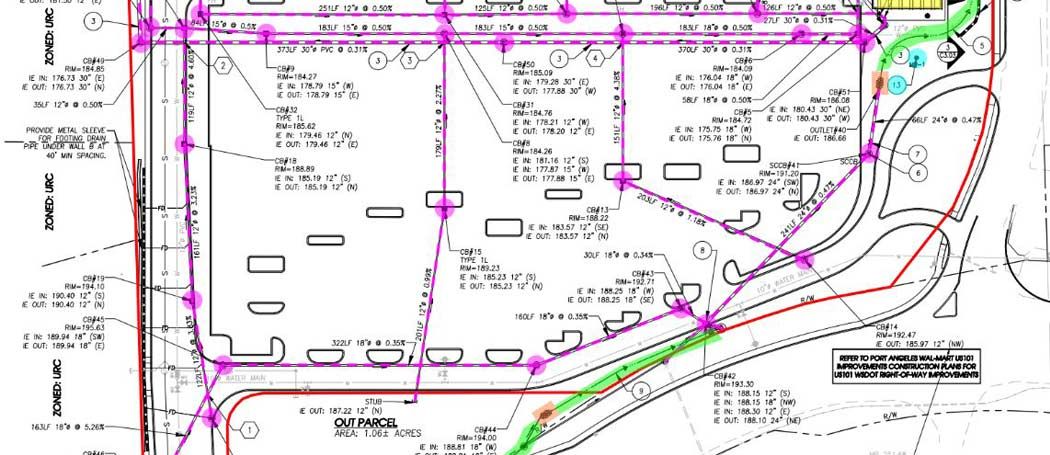Anatomy of a Parking Lot
by Jason Abert, Vice President of Service Delivery
The design and functionality of a parking lot incorporate more than asphalt and parking spaces. Parking lots are engineered to endure the weight and traffic from vehicles entering and exiting, and both minor and major runoff volumes from large rainstorm events. The parking lot of your business is often the first vantage point potential customers see, making the investment in aesthetics and functionality important. Likewise, obstructions such as standing water over parking spaces could deter potential customers both physically and psychologically. The life expectancy of a parking lot is expected to be 25-30 years, however, with improper maintenance and repairs, it may only see 10-15 years before needing major renovations[1]. Parking lots can endure several obstacles throughout their lifetime and the longevity of your infrastructure will rely heavily on stormwater management design, maintenance, and repairs.
A Lot on the Line
As construction begins, there are several factors that determine the design of your parking lot. To account for the number of permeable surfaces lost due to land development, various types of landscaping can be incorporated into the parking lot design that will help absorb runoff. The challenge with landscaped areas is that many of them are placed in aboveground beds that cannot absorb the water but rather redirect it to another location. Integrating systems that infiltrate and absorb stormwater are the key to preventing flooding in your parking lot. Stormwater control measures (SCMs) such as bioswales, permeable pavements, and catch basins can help diffuse a majority of runoff that comes from parking lots. When properly maintained, these preventative maintenance efforts can mitigate expensive renovations down the road.
Erosion, Entropy, and the Elements: A Parking Lot’s Enemies
A variety of problems can cause your parking infrastructure to fail, some of which include improper drainage, premature aging, and cracking[2]. Parking lots are oftentimes made of impervious pavement, meaning that they have a low ability to permeate water like precipitation and snow. Without proper drainage, water from these events can begin to naturally deteriorate a parking lot over time. Cracking occurs from premature aging caused by sun exposure, water, and the expansion and contraction of the asphalt that happens when water freezes and melts [2]. As the water seeps underneath the asphalt, it begins to separate the asphalt from the aggregates. The water then settles and begins to seep into lower levels of the asphalt, and the structure of the asphalt begins to alter; if the water reaches the subgrade then structural issues can begin occurring without surface visibility, threatening the livelihood of vehicles and people[3].

A parking lot will need to be repaired when potholes begin forming. This results as water from rain events appear stagnant for too long, and SCMs begins to hold water on parking surfaces for longer than intended. All could potentially cause harm to people and vehicles as they come in and out of the parking lot. Corrective actions that need to be completed to a parking lot may include repairing mortar on catch basins, replacing grates to mitigate trip and bicycle hazards, repaving asphalt, and repainting lines.
Over the lifetime of your parking lot, asphalt and permeable pavement will need to be cleaned with a street sweeper. Catch basins, as well as other stormwater control measures, will need to be cleared of debris to ensure they have the capacity to infiltrate water. The mortar on catch basins may also need to be repaired if any cracks appear. Repaving will require removing old pavement and replacing it with new pavement, however, a better option may be to resurface the pavement if applicable. Lines differentiating parking spaces need to be re-painted if they have been affected by any of the factors that have damaged the functionality of your parking lot [3].
Be Proactive, not Reactive
If a parking lot experiences minor maintenance and repairs every three to five years, it can endure the long-haul of thirty years without replacement[3]. Water that appears to be present for more than a couple of days in your parking lot could mean that you have a drainage issue occurring within your system, and a stormwater professional should be contacted so that deterioration does not begin to occur. Our industry experts can work with you to decide which stormwater features need maintenance or repairs to guarantee water infiltration.
[1] Shiu, K. N. “Extending the Service Life of Parking Structures: A Systematic Repair Approach.” Chamberlin Roofing and Waterproofing, https://www.chamberlinltd.com/extending-the-service-life-of-parking-structures-a-systematic-repair-approach/.
[2] Buncher, Mark, and Tony Kriech. “Building Parking Lots to Last.” Asphalt: The Magazine of the Asphalt Institute, http://asphaltmagazine.com/parkinglotsthatlast/.
[3] “Parking Lot Maintenance 101 for Property Managers.” DB Krieg Pavement Maintenance, https://www.dbkrieginc.com/parking-lot-maintenance.php.
 Kenosha, Wis. Highway KR Regenerative Stormwater ConveyanceThe Root-Pike Watershed Initiative Network Kenosha County, and others worked with AQUALIS to design and implement an innovative solution for stormwater control along Highway KR.
Kenosha, Wis. Highway KR Regenerative Stormwater ConveyanceThe Root-Pike Watershed Initiative Network Kenosha County, and others worked with AQUALIS to design and implement an innovative solution for stormwater control along Highway KR. Durham, N.C. Sinkhole Leads to Stormwater System RehabilitationThe tenant on this property noticed a depression that opened to the ground below and notified the property owners.
Durham, N.C. Sinkhole Leads to Stormwater System RehabilitationThe tenant on this property noticed a depression that opened to the ground below and notified the property owners.


